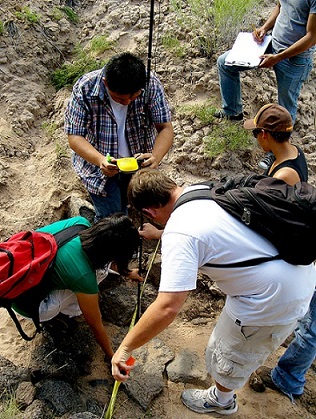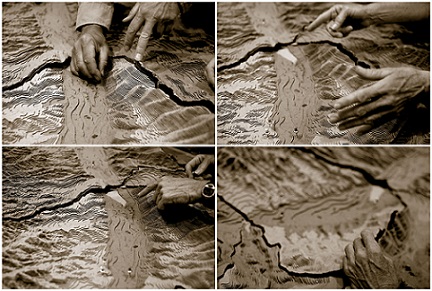IN THIS ISSUE:
Grantee Spotlight: Arid Lands Institute Plans for Water-Stressed Communities
Understanding the Impact of Anchor Institutions on Low-Income Communities
Recap: Anchor Institutions Task Force 2013 Annual Conference
Grantee Spotlight: Arid Lands Institute Plans for Water-Stressed Communities

Student research and community assistance teams performed a geospatial survey of early twentieth century erosion control projects in the Embudo community of Rio Arriba County, New Mexico. Image courtesy of the Arid Lands Institute.
In 2007, students from the School of Architecture at Woodbury University, a private, nonprofit university in Burbank, California, began working on solutions to water and energy issues in Western arid landscapes. The following year, Woodbury established the Arid Lands Institute (ALI), a research and outreach center in the School of Architecture that now houses classes related to drylands design. ALI’s projects have offered Woodbury students valuable opportunities to work in the field and develop conservation-focused design skills; they have also helped water-stressed communities become more sustainable through careful planning and working with the local communities for available water resources.
Gaining Experience in the Drylands
To help bring drylands design to Western communities, ALI received a three-year Hispanic-Serving Institutions Assisting Communities (HSIAC) grant from HUD in 2009. Historically, communities in arid landscapes throughout the West have constructed water-related infrastructure that is energy intensive with little regard for its effect on surrounding areas or the natural environment. In Burbank and similar places, water has to be imported because these construction practices have depleted groundwater resources and reduced water quality. In other communities, such as Rio Arriba County, New Mexico, entire watersheds need to be restored after years of overgrazing and excessive logging activity.
ALI used the $600,000 grant to develop viable design and planning solutions to water and energy conservation issues in Burbank and Rio Arriba County, New Mexico. The grant projects involved more than 350 students in service learning activities in the two communities and more than 150 student-led design projects.
Students worked for three years with Burbank during the school year and with communities in the Lower Embudo Valley in Rio Arriba County in the summer. In the first year, students conducted research and analysis, including training community members to find and map streams and other watercourses using global positioning systems. With this information, students created high-resolution models of the communities’ watersheds to identify areas that were in danger of being overtaken by vegetation or prone to erosion or flooding. In the second year, students focused on strategies to make water-related infrastructure and landscapes more sustainable and conservation focused, such as stormwater harvesting and the use of diversion dams. In the third year, students explored building systems to implement some of these strategies.
The grant activities also included several public education efforts. ALI conducted five major events targeted at low- and moderate-income residents of Burbank and Rio Arriba focusing on water- and energy-efficient design in arid landscapes. These events included two 3-day Celebrando las Acequias symposiums in the Lower Embudo Valley, one held in 2010 and one in 2011. The symposiums offered a forum for the community farmers and local food advocates as well as architects, artists, archeologists, hydrologists, and engineers to make presentations and gain knowledge about the history and future of communal irrigation societies. ALI also sponsored a lecture series; half-day, small-systems design seminars; and the Drylands Design Conference. ALI reached more than 3,000 people through these events, which were covered in prominent architecture magazines and other national media outlets. Concurrent with the Drylands Design Conference, ALI held a Drylands Design Competition, in which more than 80 students and professionals submitted design solutions for issues in water-stressed communities.

In summer 2010, ALI students created a contour model of the Lower Embudo Valley in Rio Arriba County, New Mexico. The model helped students and community members to better understand how the landscape affected water flow in the valley’s acequia communities. Image courtesy of the Arid Lands Institute.
ALI also used the grant to prepare and disseminate print and online materials about water and energy conservation that emphasized university-community collaboration. ALI made presentations from the Drylands Design Conference and several other events available to the public in its video library. ALI has added a gallery of adaptive strategies for water-stressed environments and descriptions of all ALI projects to its website.
Continuing the Mission to Improve Watersheds in the West
Although the HSIAC grant ended in 2012, ALI is continuing to map and model watersheds in the West to implement low-impact design retrofits and help communities become more sustainable. According to Peter Arnold, founding codirector of ALI, the HSIAC grant has led to ongoing work with Burbank, as well as partnerships with government entities and local organizations in Rio Arriba County. Based on its experience in Burbank, ALI recently completed a study for the Metropolitan Water District of Southern California of stormwater capture potential throughout the San Fernando Valley called “Where Is It? Let’s ReUse It!”
In New Mexico, ALI research in Embudo/Dixon has led to the area’s valley-wide planning effort. “Agua Limpia: Clean Water for the Lower Embudo Valley” is an EPA-funded watershed-based planning effort occurring from 2013 to 2015. ALI is working with local partners and community citizen-scientists to monitor rainfall, snowmelt, runoff, and sedimentation to identify sites of surface water impairment and potential sites for future design intervention. Local watershed leaders have expressed appreciation for ALI’s work in the community; according to David Valdez, president of Acequia de La Plaza de Dixon, ALI’s efforts were essential to preserving the traditional irrigation ditch (acequia) systems and “assuring the continued farming practices of the commercial and the traditional small time farmer.” Valdez also notes that their experience with ALI helped Acequia de La Plaza de Dixon raise additional funding for water infrastructure improvements.
ALI’s first two years of work in Rio Arriba County were the subject of an article in the September 13, 2011 edition of PD&R EDGE.


